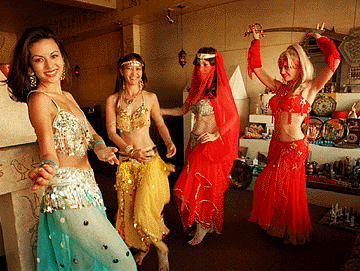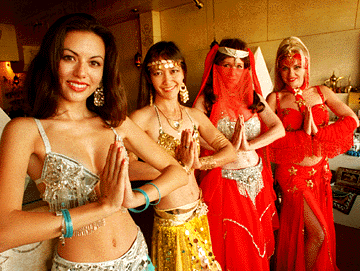
From left, belly dancers Willow Chang, Allison Chun Smith, Suzanne Hamdi and Michella Baker Photos by Dennis Oda, Star-Bulletin

From left, belly dancers Willow Chang, Allison Chun Smith, Suzanne Hamdi and Michella Baker Photos by Dennis Oda, Star-Bulletin
With last month's bombing in Saudi Arabia and the region's troubled history, the word likely to pop up is "terrorism." But there's a group in Hawaii that wants to change that response to "dance."
The organization's name is Middle Eastern Dance Artists of Hawaii or Madah, and its members specialize in belly dancing.
"Belly dancing in Hawaii?" says dancer Willow Chang. "It's alive and kicking. You have to turn over a couple of rocks to find it because it's not as accessible as ballet, jazz or hula."
Or as familiar and well-understood. Misconceptions flourish about the ancient art form: That it is a dance of seduction, done primarily to entertain men; that it is a form of striptease, a come-on for prostitution; that it is seedy enough to be the subject matter of Demi Moore's next movie.
Not so, Medah members say. An examination of Arabic dance history and its modern practice around the world supports their assertion that belly dancing is done by women for other women, to celebrate femininity and not to entice men.
"A lot of people think that it's about wearing a very skimpy and very gaudy costume and getting up there and really putting on a show," says dancer Shehzi Khan. The custom of tipping also clouds its image. Traditional in the Arab world, tipping a dancer is most associated in America with stripping.
Instead, belly dancing is about forming emotional connections: between music and dance, dancer and spectator. Teacher Glo Ayson exhorts her students to "know your music inside and out." Dance steps, whether choreographed or free-form, should emerge from patterns in the music.
"The beat and the singer's voice determine your movements," Khan adds. "It should evoke a certain type of emotion from you." The dance can then become, according to Chang, a "means of communicating and bonding" with the audience. Enthusiastically clapping along with the music, the viewers in turn further inspire the dancer and invigorate the dance.
Hoping to raise awareness as well as funds, Medah is holding a benefit Wednesday evening at the Pyramids restaurant in Kapahulu.
After a recent Sunday night class, four dancers sat down to talk about how they got involved in Arabic dance, and what it has brought to their lives.
Stereotypes dissolve in the range of their professions, ages and backgrounds.
Chang, 24 and a part-time student at Kapiolani Community College, dances professionally in several genres and dabbles in modeling. Khan, the youngest member of Medah at 21, graduates from the University of Hawaii this winter with a degree in international relations.
Ayson and Suzanne Hamdi, both in their 40s, belly dance and teach professionally, but have day jobs as well. Ayson teaches music to elementary school children, and Hamdi is an ordained minister.
Why do four busy women devote themselves to studying and performing a dance from halfway around the world? All four came to belly dancing after previous experience with other types of dance, especially hula and ballet. Also, all have traveled to the Middle East (Egypt, in particular), which either led to or resulted from a fascination with Arabic dance.

"It is such a dignified, graceful way of expressing your femininity without having to be so overt about it," she says. Belly dancing has also helped her to overcome her natural shyness, she said. After less than two years of dancing, the fund-raiser marks her first public appearance.
Ayson started 18 years ago, after a belly-dancing performance at a "Mediterranean night" party "totally captivated" her. She, like Khan, says the dancing helped her conquer shyness and insecurity about her body image and she tries to pass this aspect on to her students.
Medah has members shimmying their way into their mid-70s. "It's a dance of the experience of life," Ayson says. Hamdi agrees that a belly dancer improves with age. "As you grow older you can put more of your emotions and life experience into it, and it actually makes you a more interesting dancer." Some of Egypt's most revered - and well-paid - dancers today are in their 50s.
Hamdi originally got into belly dancing on the advice of her hula instructor as a way to loosen up her hips. She now teaches and dances professionally and has performed across Asia, Africa and the South Pacific. "Music and dance are translatable in any language, in any country."
Two years ago, Chang spent six months in Cairo dancing in, believe it or not, a Hawaiian and Polynesian revue. She found there that "belly dancing encompasses everything that a woman can be." Unlike ballet, which stresses conformity to an unnatural physical standard, "flat-footed, earthy" belly dancing welcomes all body types.
"The ideal body type for a belly dancer is to have a belly." Well, not a beer gut, Chang adds. But "it's OK to have curves, because the more curves you have, the more you have to shake, the more womanly you are."
Belly dancers are encouraged to study with a variety of mentors. Medah sponsors workshops with guest teachers from the mainland and lists in its newsletter classes by several island instructors.
In the near future, Medah members hope to expose a wider public to the fun and the history of belly dancing by giving lecture/demonstrations at popular bookstores and the Honolulu Academy of Arts. A long-term goal is to present a Middle Eastern Festival, akin to the popular annual Greek Festival. "Using culture as a means to educate people" is the "best and easiest way," Chang says.
With the intimacy of Hawaii's Middle Eastern community - small groups with close ties - a special opportunity for cultural understanding exists. Hamdi says the different groups get together here for parties. With more similarities than differences in their tastes, Arabs and Israelis share food and entertainment side by side.
THE historical origins of belly dancing are somewhat murky. Wall and vase paintings from the tombs of ancient Egyptian pharaohs depict women dancing, but frozen images only hint at what the movements were.Another theory claims belly dancing evolved through travel, culture and time with gypsies and along trade routes.
Supporting this idea are the similarities in instrumentation and movement with everything from Spanish flamenco to dances of the Indian subcontinent.
In the 1960s, Egypt attempted to ban belly dancing - in a nod to both Islamic fundamentalism and modernity - and supplant it with ballet. However, since belly dancing was taught within the family, not in schools or books, it continued to flourish underground. Just as when missionaries condemned hula, a legal ban could not kill deeply rooted cultural tradition.
Today two belly dancing styles flourish: traditional and cabaret.
The traditional (also called ethnic or Bedouin) style is the desert type of dance, performed to heavy, folkloric music. Dancers wear a "baladi" dress, covering the body from head to toe. A scarf, tied low like a Tahitian grass skirt, accentuates hip motions. It is most commonly danced privately, in the company of female relatives.
Westerners are more familiar with the cabaret (or Egyptian) style, caricatured but also popularized by 1920s Hollywood cinema. It is performed publicly in the Middle East at nightclubs, casinos and weddings. The dancer wears a veil, a top, hip belt, and harem pants or skirt, and chooses from a range of music.
Costumes also vary from country to country. Turkey permits more revealing garb, but Egypt requires more conservative attire. A body stocking must cover the dancer's abdomen or she risks arrest.
Optional implements add variety to the dance: finger cymbals; veils; canes shaped like a shepherd's crooks; swords balanced on the head or hip; or a giant candelabra, traditionally balanced on the head at weddings.
What: "Summer Celebration," a benefit for Middle Eastern Dance Artists of Hawaii
When: 5 and 8 p.m. Wednesday
Where: Pyramids restaurant
Cost: $30, includes prix fixe Egyptian dinner and dancing performances
Information: 941-2026